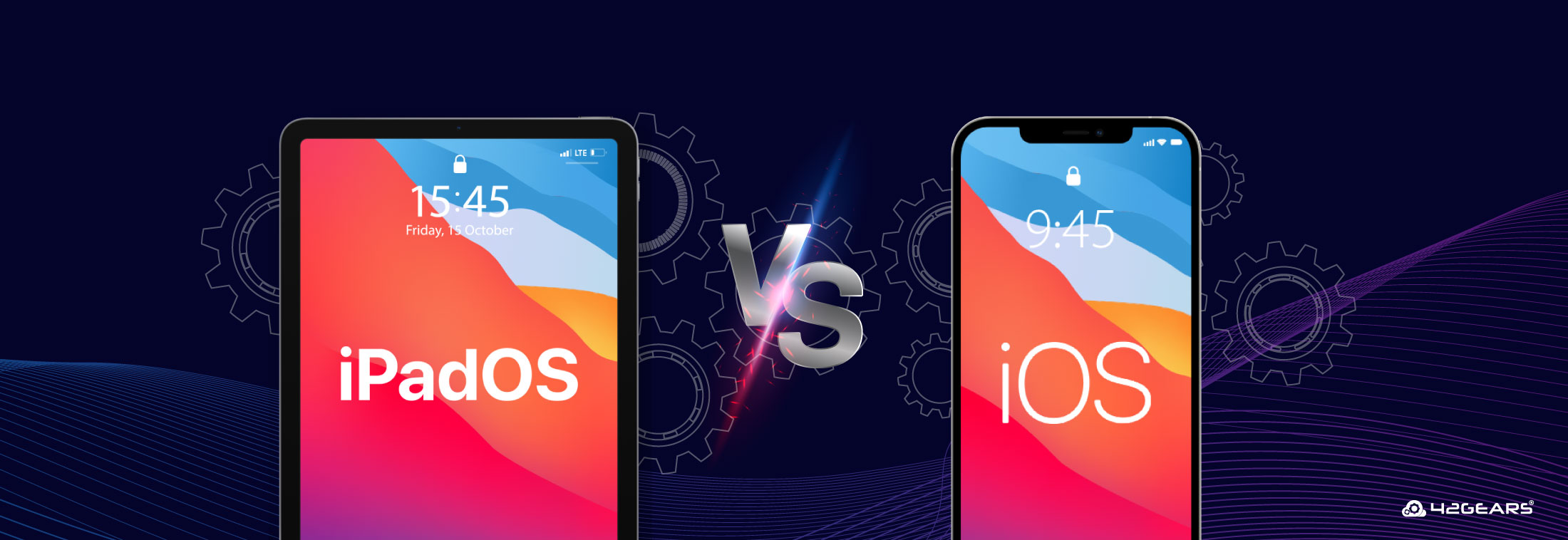iPadOS vs. iOS: What’s the Difference and Why It Matters?
Apr 24, 2025 | 42Gears Team
iPad owners were likely surprised in 2019 by the creation of a brand-new operating system specifically for Apple's tablet line, known as iPadOS. Until then, iPhones and iPads shared the same operating system — iOS. But when Apple introduced iPadOS as a distinct platform — complete with its own features and update cycle — it raised a question that is still common today: what exactly is the difference between iOS and iPadOS?
It only takes a quick glance at iPadOS and iOS to see they are quite similar. That said, there are some key differences between them. Whether you use iPads and iPhones in the office or at home, it's worth knowing what distinguishes them from each other.
iPadOS: Reflecting the iPad's Laptop-Style Capabilities
iPadOS is a dedicated version of the iOS operating system, designed exclusively for iPads. While it shares much of its core code with iOS (and even other platforms like tvOS and watchOS), iPadOS is optimized to make the most of the iPad’s larger display and enhanced capabilities.
Like other Apple operating systems, iPadOS is closed-source and built to run only on Apple-designed processors. It can't be installed on non-Apple hardware, and Apple limits how much of the system users can customize.
One of the biggest iPadOS vs iOS differentiators is the ability to display multiple apps on screen at once. Naturally, this leverages the iPad's larger screen as compared to that of an iPhone. Multitasking enables two apps to share the screen (via Split View), or open an app on top of another using the Slide Over feature. On an iPhone, this would likely be quite cluttered, but on an iPad, each app still has enough screen space to be usable.
Here’s how iPadOS stands out:
- Multitasking Made Easy
Use two apps side by side with Split View or open a second app over another using Slide Over—perfect for getting more done on the iPad's larger screen. - Exclusive Apple Pencil Support
Only iPads support the Apple Pencil, which allows for handwriting, drawing, and even smart gestures like circling text to highlight it. iPads are especially popular among creatives for graphic design, sketching, and annotating mockups on the go. - Scribble Turns Handwriting into Text
With Scribble, you can write with the Apple Pencil in any text field and have your handwriting automatically converted into typed text. - Apps Designed Just for iPad
Some apps are built specifically for iPad to take full advantage of the larger display—offering better layouts and features than their iPhone counterparts. - Mac Catalyst for Cross-Platform App Development
Developers can use Mac Catalyst to bring iPad apps to macOS, making it easier to build apps that work well across both platforms with shared code.
iOS: Size and Mobile Connectivity Define Exclusive Features
iOS continues to power the iPhone and is designed with portability, one-handed use, and mobile-first features in mind. Its design prioritizes simplicity and fast access to essential apps and services.
Here's what makes iOS unique:
- Works with Apple Watch
Only iPhones can be paired directly with Apple Watches. You’ll need an iPhone to manage and use all Apple Watch features. - Supports CarPlay
iOS devices can connect to supported car systems to use a simplified version of iOS on your car's display—perfect for calls, maps, and music while driving. - Comes with iPhone-Only Apps
Certain Apple apps like Health and Translate are only available on iPhones, even though technically they could work on iPads too. - Designed for Smaller Screens
iOS is built for quick, one-handed use—ideal for mobile tasks on the go.
Managing iOS and iPadOS Devices
There are many similarities between iPadOS and iOS, whether you're comparing them for use at home or in the office. Both support the same Apple ID features, use similar interface designs, and allow for app syncing across devices. More importantly for businesses, both platforms can be centrally managed.
Organizations can use Apple Business Manager or Apple School Manager to enroll and supervise iPads and iPhones in bulk. And to streamline control even further, IT teams can use a mobile device management (MDM) solution.
Enter SureMDM: Unified Device Management for iOS and iPadOS
If you’re looking for a flexible, cross-platform MDM solution, SureMDM by 42Gears is a smart choice. Whether your organization uses iPads for design work or iPhones for communication, SureMDM makes it easy with the below capabilities:
- Quick device enrollment
- Support for COD and BYOD scenarios
- Monitor device parameters
- Remote screen view to troubleshoot issues
- Ensure device compliance
- Push apps and updates
- Convert iOS and iPadOS devices into kiosk mode
Plus, SureMDM supports Android, Windows, macOS, and Linux, so it’s perfect for businesses managing a diverse device fleet.
iOS/iPadOS Device Management – Watch How SureMDM Makes It Easy!
iPadOS vs iOS: Quick Summary
| Feature | iOS | iPadOS |
| Device Type | iPhones | iPads only |
| Design Focus | Optimized for small screens and portability | Optimized for large screens and productivity |
| Multitasking | Not supported | Supported (Split View, Slide Over, Stage Manager) |
| Apple Pencil Support | Not supported | Fully supported |
| Exclusive Apps | Health, Translate, and some iPhone-only apps | iPad-only apps and optimized versions of iOS apps |
| Apple Watch Pairing | Yes | No |
| CarPlay Support | Yes | No |
| Latest Version | iOS 18 | iPadOS 18 |
Want to ensure your Apple devices are secure and easy to manage? Try out SureMDM and how it can simplify your device management strategy today.
Struggling with iOS Device Management?
See How SureMDM Simplifies It. For Free.
Subscribe for our free newsletter


